Customer Relationships & Social Media: A Mark & Spencer Analysis
VerifiedAdded on 2020/01/07
|29
|7835
|322
Report
AI Summary
This report delves into the significant impact of social media on customer relationships, using Mark & Spencer as a case study. It begins with an introduction outlining the research background, aims, objectives, research questions, and methodology, including an inductive approach, interpretivist philosophy, and descriptive design. The literature review explores the rising trends of social media and the core concept of customer relationships, emphasizing factors affecting these relationships. The research methodology section details data collection through surveys and secondary sources, employing simple random sampling with a sample size of 50 customers and thematic data analysis. The report is structured into five chapters, covering the introduction, literature review, research methodology, data analysis, and conclusions with recommendations. The findings highlight how social media platforms are utilized to enhance customer engagement, brand perception, and overall customer relationship management within the context of Mark & Spencer. The report also acknowledges the challenges of social media, such as managing the rapid circulation of information and its impact on brand reputation. The conclusion summarizes the key findings and suggests areas for further study to optimize social media strategies for improved customer relationships.

Research Project
Paraphrase This Document
Need a fresh take? Get an instant paraphrase of this document with our AI Paraphraser
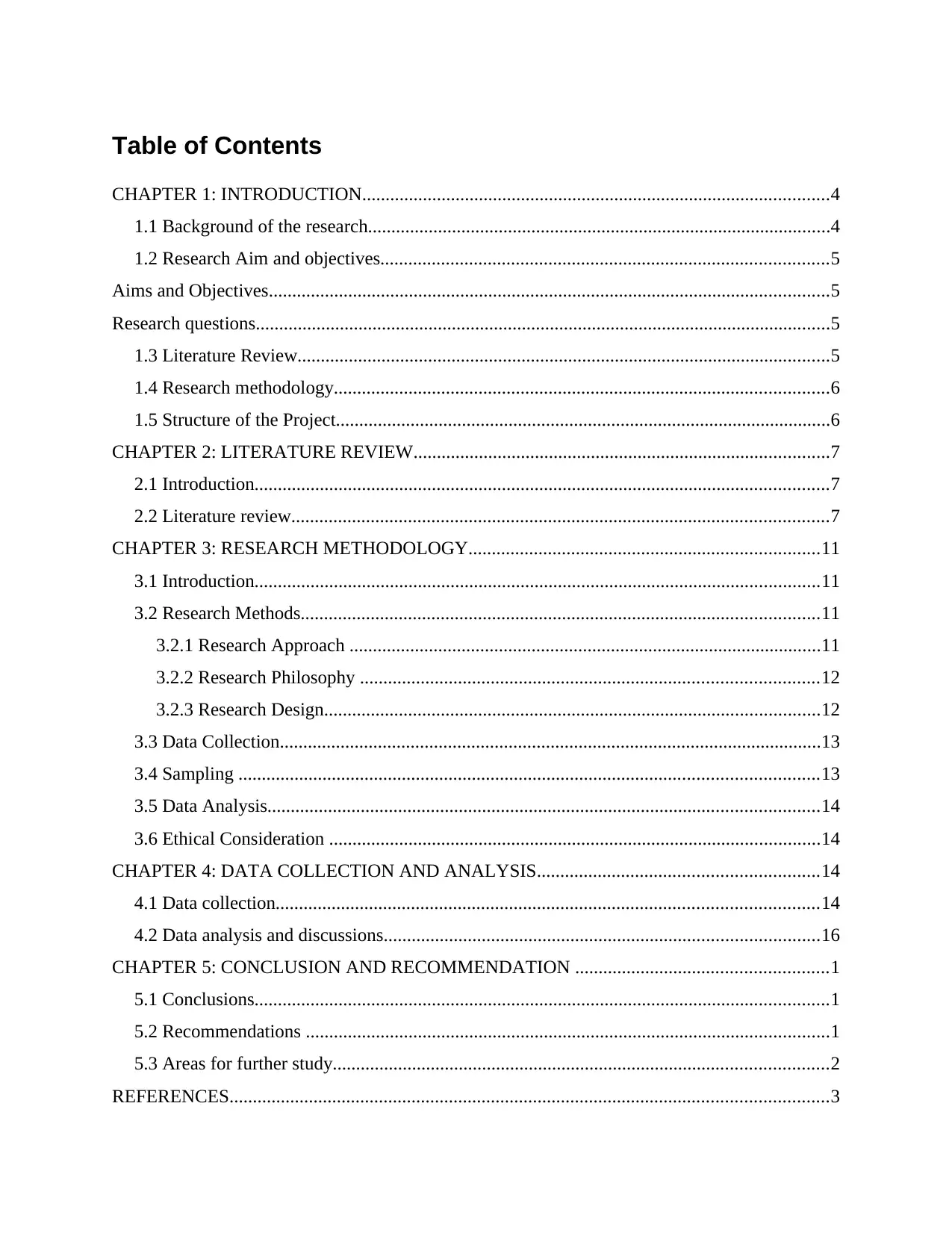
Table of Contents
CHAPTER 1: INTRODUCTION....................................................................................................4
1.1 Background of the research...................................................................................................4
1.2 Research Aim and objectives................................................................................................5
Aims and Objectives........................................................................................................................5
Research questions...........................................................................................................................5
1.3 Literature Review..................................................................................................................5
1.4 Research methodology..........................................................................................................6
1.5 Structure of the Project..........................................................................................................6
CHAPTER 2: LITERATURE REVIEW.........................................................................................7
2.1 Introduction...........................................................................................................................7
2.2 Literature review...................................................................................................................7
CHAPTER 3: RESEARCH METHODOLOGY...........................................................................11
3.1 Introduction.........................................................................................................................11
3.2 Research Methods...............................................................................................................11
3.2.1 Research Approach .....................................................................................................11
3.2.2 Research Philosophy ..................................................................................................12
3.2.3 Research Design..........................................................................................................12
3.3 Data Collection....................................................................................................................13
3.4 Sampling ............................................................................................................................13
3.5 Data Analysis......................................................................................................................14
3.6 Ethical Consideration .........................................................................................................14
CHAPTER 4: DATA COLLECTION AND ANALYSIS............................................................14
4.1 Data collection....................................................................................................................14
4.2 Data analysis and discussions.............................................................................................16
CHAPTER 5: CONCLUSION AND RECOMMENDATION ......................................................1
5.1 Conclusions...........................................................................................................................1
5.2 Recommendations ................................................................................................................1
5.3 Areas for further study..........................................................................................................2
REFERENCES................................................................................................................................3
CHAPTER 1: INTRODUCTION....................................................................................................4
1.1 Background of the research...................................................................................................4
1.2 Research Aim and objectives................................................................................................5
Aims and Objectives........................................................................................................................5
Research questions...........................................................................................................................5
1.3 Literature Review..................................................................................................................5
1.4 Research methodology..........................................................................................................6
1.5 Structure of the Project..........................................................................................................6
CHAPTER 2: LITERATURE REVIEW.........................................................................................7
2.1 Introduction...........................................................................................................................7
2.2 Literature review...................................................................................................................7
CHAPTER 3: RESEARCH METHODOLOGY...........................................................................11
3.1 Introduction.........................................................................................................................11
3.2 Research Methods...............................................................................................................11
3.2.1 Research Approach .....................................................................................................11
3.2.2 Research Philosophy ..................................................................................................12
3.2.3 Research Design..........................................................................................................12
3.3 Data Collection....................................................................................................................13
3.4 Sampling ............................................................................................................................13
3.5 Data Analysis......................................................................................................................14
3.6 Ethical Consideration .........................................................................................................14
CHAPTER 4: DATA COLLECTION AND ANALYSIS............................................................14
4.1 Data collection....................................................................................................................14
4.2 Data analysis and discussions.............................................................................................16
CHAPTER 5: CONCLUSION AND RECOMMENDATION ......................................................1
5.1 Conclusions...........................................................................................................................1
5.2 Recommendations ................................................................................................................1
5.3 Areas for further study..........................................................................................................2
REFERENCES................................................................................................................................3

⊘ This is a preview!⊘
Do you want full access?
Subscribe today to unlock all pages.

Trusted by 1+ million students worldwide
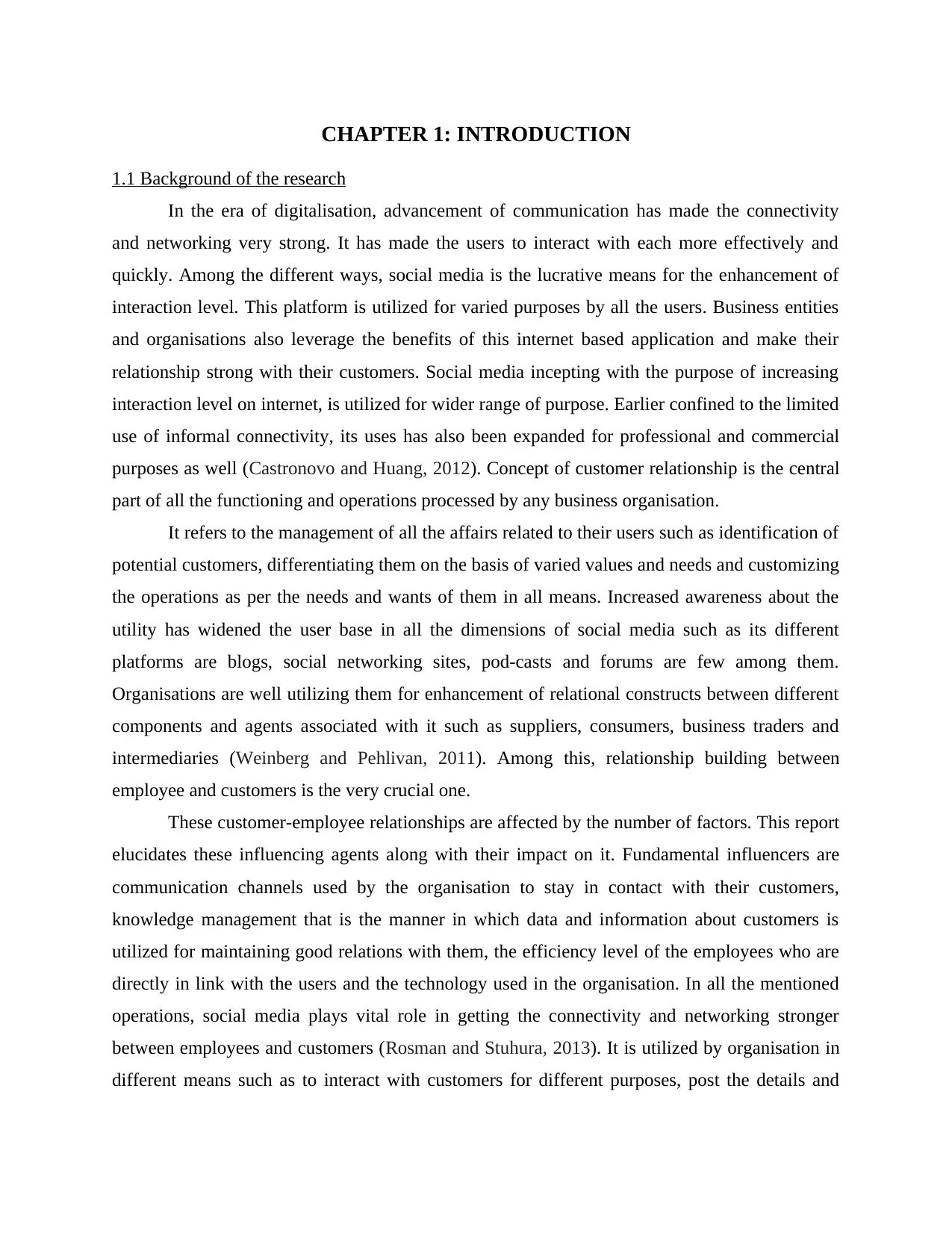
CHAPTER 1: INTRODUCTION
1.1 Background of the research
In the era of digitalisation, advancement of communication has made the connectivity
and networking very strong. It has made the users to interact with each more effectively and
quickly. Among the different ways, social media is the lucrative means for the enhancement of
interaction level. This platform is utilized for varied purposes by all the users. Business entities
and organisations also leverage the benefits of this internet based application and make their
relationship strong with their customers. Social media incepting with the purpose of increasing
interaction level on internet, is utilized for wider range of purpose. Earlier confined to the limited
use of informal connectivity, its uses has also been expanded for professional and commercial
purposes as well (Castronovo and Huang, 2012). Concept of customer relationship is the central
part of all the functioning and operations processed by any business organisation.
It refers to the management of all the affairs related to their users such as identification of
potential customers, differentiating them on the basis of varied values and needs and customizing
the operations as per the needs and wants of them in all means. Increased awareness about the
utility has widened the user base in all the dimensions of social media such as its different
platforms are blogs, social networking sites, pod-casts and forums are few among them.
Organisations are well utilizing them for enhancement of relational constructs between different
components and agents associated with it such as suppliers, consumers, business traders and
intermediaries (Weinberg and Pehlivan, 2011). Among this, relationship building between
employee and customers is the very crucial one.
These customer-employee relationships are affected by the number of factors. This report
elucidates these influencing agents along with their impact on it. Fundamental influencers are
communication channels used by the organisation to stay in contact with their customers,
knowledge management that is the manner in which data and information about customers is
utilized for maintaining good relations with them, the efficiency level of the employees who are
directly in link with the users and the technology used in the organisation. In all the mentioned
operations, social media plays vital role in getting the connectivity and networking stronger
between employees and customers (Rosman and Stuhura, 2013). It is utilized by organisation in
different means such as to interact with customers for different purposes, post the details and
1.1 Background of the research
In the era of digitalisation, advancement of communication has made the connectivity
and networking very strong. It has made the users to interact with each more effectively and
quickly. Among the different ways, social media is the lucrative means for the enhancement of
interaction level. This platform is utilized for varied purposes by all the users. Business entities
and organisations also leverage the benefits of this internet based application and make their
relationship strong with their customers. Social media incepting with the purpose of increasing
interaction level on internet, is utilized for wider range of purpose. Earlier confined to the limited
use of informal connectivity, its uses has also been expanded for professional and commercial
purposes as well (Castronovo and Huang, 2012). Concept of customer relationship is the central
part of all the functioning and operations processed by any business organisation.
It refers to the management of all the affairs related to their users such as identification of
potential customers, differentiating them on the basis of varied values and needs and customizing
the operations as per the needs and wants of them in all means. Increased awareness about the
utility has widened the user base in all the dimensions of social media such as its different
platforms are blogs, social networking sites, pod-casts and forums are few among them.
Organisations are well utilizing them for enhancement of relational constructs between different
components and agents associated with it such as suppliers, consumers, business traders and
intermediaries (Weinberg and Pehlivan, 2011). Among this, relationship building between
employee and customers is the very crucial one.
These customer-employee relationships are affected by the number of factors. This report
elucidates these influencing agents along with their impact on it. Fundamental influencers are
communication channels used by the organisation to stay in contact with their customers,
knowledge management that is the manner in which data and information about customers is
utilized for maintaining good relations with them, the efficiency level of the employees who are
directly in link with the users and the technology used in the organisation. In all the mentioned
operations, social media plays vital role in getting the connectivity and networking stronger
between employees and customers (Rosman and Stuhura, 2013). It is utilized by organisation in
different means such as to interact with customers for different purposes, post the details and
Paraphrase This Document
Need a fresh take? Get an instant paraphrase of this document with our AI Paraphraser
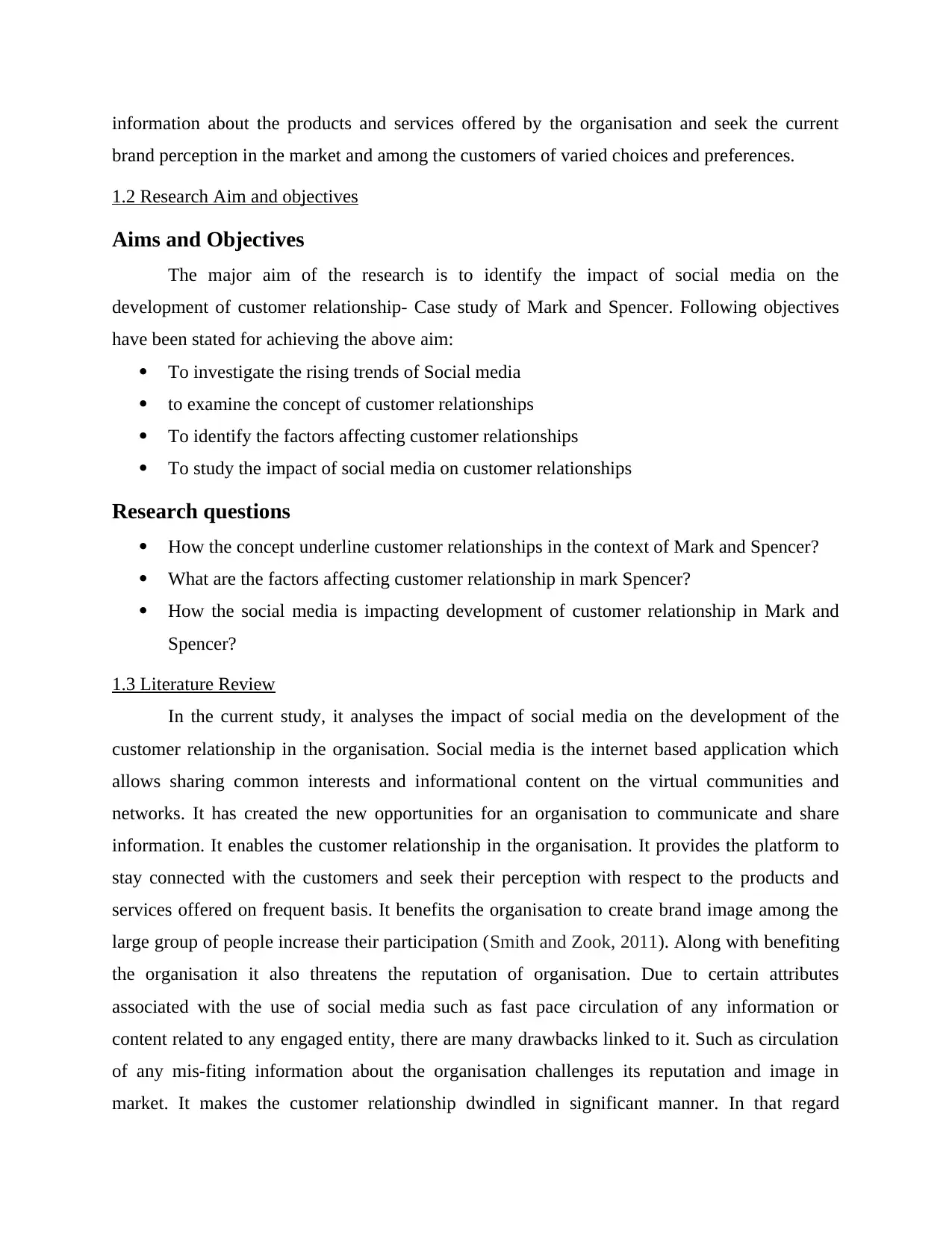
information about the products and services offered by the organisation and seek the current
brand perception in the market and among the customers of varied choices and preferences.
1.2 Research Aim and objectives
Aims and Objectives
The major aim of the research is to identify the impact of social media on the
development of customer relationship- Case study of Mark and Spencer. Following objectives
have been stated for achieving the above aim:
To investigate the rising trends of Social media
to examine the concept of customer relationships
To identify the factors affecting customer relationships
To study the impact of social media on customer relationships
Research questions
How the concept underline customer relationships in the context of Mark and Spencer?
What are the factors affecting customer relationship in mark Spencer?
How the social media is impacting development of customer relationship in Mark and
Spencer?
1.3 Literature Review
In the current study, it analyses the impact of social media on the development of the
customer relationship in the organisation. Social media is the internet based application which
allows sharing common interests and informational content on the virtual communities and
networks. It has created the new opportunities for an organisation to communicate and share
information. It enables the customer relationship in the organisation. It provides the platform to
stay connected with the customers and seek their perception with respect to the products and
services offered on frequent basis. It benefits the organisation to create brand image among the
large group of people increase their participation (Smith and Zook, 2011). Along with benefiting
the organisation it also threatens the reputation of organisation. Due to certain attributes
associated with the use of social media such as fast pace circulation of any information or
content related to any engaged entity, there are many drawbacks linked to it. Such as circulation
of any mis-fiting information about the organisation challenges its reputation and image in
market. It makes the customer relationship dwindled in significant manner. In that regard
brand perception in the market and among the customers of varied choices and preferences.
1.2 Research Aim and objectives
Aims and Objectives
The major aim of the research is to identify the impact of social media on the
development of customer relationship- Case study of Mark and Spencer. Following objectives
have been stated for achieving the above aim:
To investigate the rising trends of Social media
to examine the concept of customer relationships
To identify the factors affecting customer relationships
To study the impact of social media on customer relationships
Research questions
How the concept underline customer relationships in the context of Mark and Spencer?
What are the factors affecting customer relationship in mark Spencer?
How the social media is impacting development of customer relationship in Mark and
Spencer?
1.3 Literature Review
In the current study, it analyses the impact of social media on the development of the
customer relationship in the organisation. Social media is the internet based application which
allows sharing common interests and informational content on the virtual communities and
networks. It has created the new opportunities for an organisation to communicate and share
information. It enables the customer relationship in the organisation. It provides the platform to
stay connected with the customers and seek their perception with respect to the products and
services offered on frequent basis. It benefits the organisation to create brand image among the
large group of people increase their participation (Smith and Zook, 2011). Along with benefiting
the organisation it also threatens the reputation of organisation. Due to certain attributes
associated with the use of social media such as fast pace circulation of any information or
content related to any engaged entity, there are many drawbacks linked to it. Such as circulation
of any mis-fiting information about the organisation challenges its reputation and image in
market. It makes the customer relationship dwindled in significant manner. In that regard
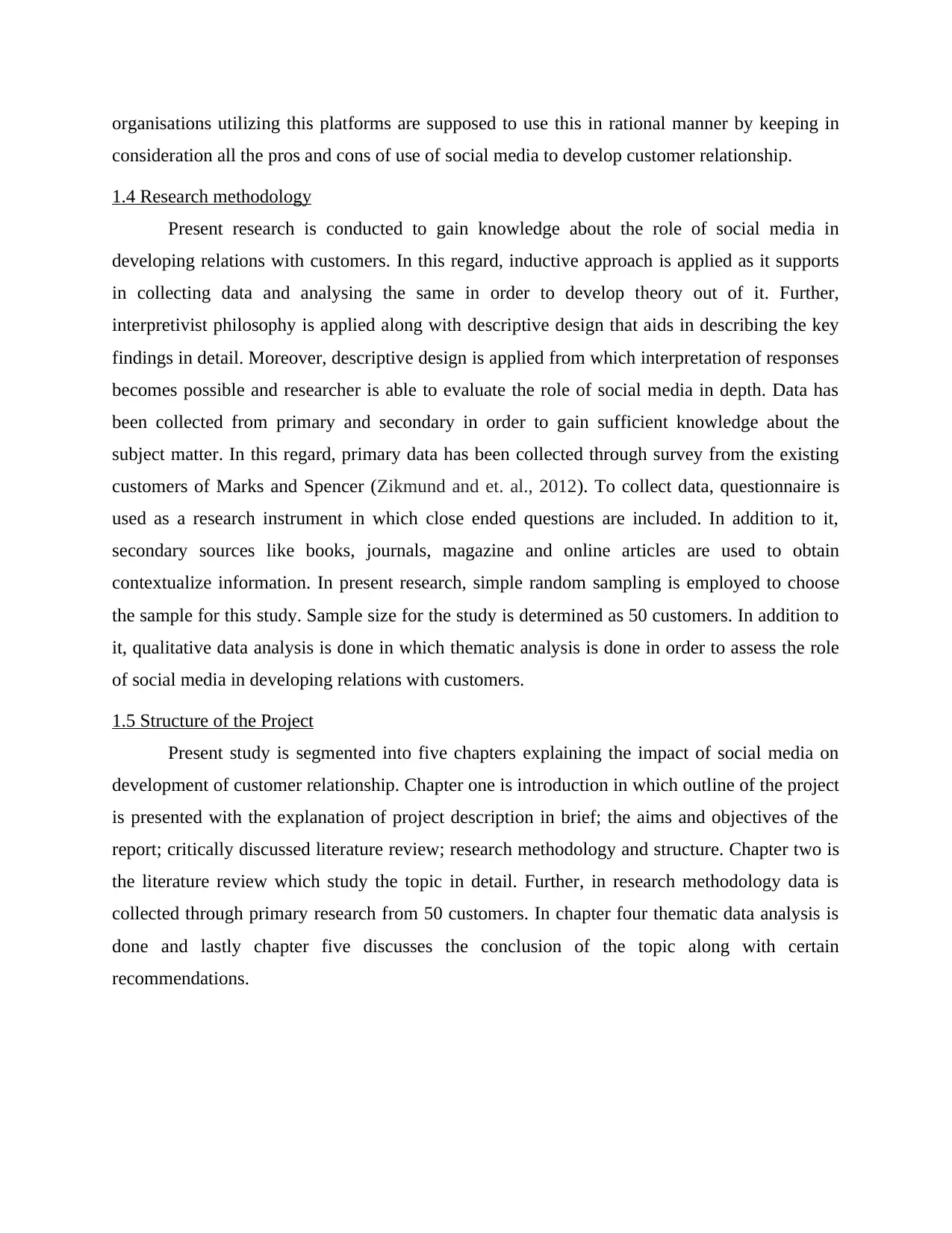
organisations utilizing this platforms are supposed to use this in rational manner by keeping in
consideration all the pros and cons of use of social media to develop customer relationship.
1.4 Research methodology
Present research is conducted to gain knowledge about the role of social media in
developing relations with customers. In this regard, inductive approach is applied as it supports
in collecting data and analysing the same in order to develop theory out of it. Further,
interpretivist philosophy is applied along with descriptive design that aids in describing the key
findings in detail. Moreover, descriptive design is applied from which interpretation of responses
becomes possible and researcher is able to evaluate the role of social media in depth. Data has
been collected from primary and secondary in order to gain sufficient knowledge about the
subject matter. In this regard, primary data has been collected through survey from the existing
customers of Marks and Spencer (Zikmund and et. al., 2012). To collect data, questionnaire is
used as a research instrument in which close ended questions are included. In addition to it,
secondary sources like books, journals, magazine and online articles are used to obtain
contextualize information. In present research, simple random sampling is employed to choose
the sample for this study. Sample size for the study is determined as 50 customers. In addition to
it, qualitative data analysis is done in which thematic analysis is done in order to assess the role
of social media in developing relations with customers.
1.5 Structure of the Project
Present study is segmented into five chapters explaining the impact of social media on
development of customer relationship. Chapter one is introduction in which outline of the project
is presented with the explanation of project description in brief; the aims and objectives of the
report; critically discussed literature review; research methodology and structure. Chapter two is
the literature review which study the topic in detail. Further, in research methodology data is
collected through primary research from 50 customers. In chapter four thematic data analysis is
done and lastly chapter five discusses the conclusion of the topic along with certain
recommendations.
consideration all the pros and cons of use of social media to develop customer relationship.
1.4 Research methodology
Present research is conducted to gain knowledge about the role of social media in
developing relations with customers. In this regard, inductive approach is applied as it supports
in collecting data and analysing the same in order to develop theory out of it. Further,
interpretivist philosophy is applied along with descriptive design that aids in describing the key
findings in detail. Moreover, descriptive design is applied from which interpretation of responses
becomes possible and researcher is able to evaluate the role of social media in depth. Data has
been collected from primary and secondary in order to gain sufficient knowledge about the
subject matter. In this regard, primary data has been collected through survey from the existing
customers of Marks and Spencer (Zikmund and et. al., 2012). To collect data, questionnaire is
used as a research instrument in which close ended questions are included. In addition to it,
secondary sources like books, journals, magazine and online articles are used to obtain
contextualize information. In present research, simple random sampling is employed to choose
the sample for this study. Sample size for the study is determined as 50 customers. In addition to
it, qualitative data analysis is done in which thematic analysis is done in order to assess the role
of social media in developing relations with customers.
1.5 Structure of the Project
Present study is segmented into five chapters explaining the impact of social media on
development of customer relationship. Chapter one is introduction in which outline of the project
is presented with the explanation of project description in brief; the aims and objectives of the
report; critically discussed literature review; research methodology and structure. Chapter two is
the literature review which study the topic in detail. Further, in research methodology data is
collected through primary research from 50 customers. In chapter four thematic data analysis is
done and lastly chapter five discusses the conclusion of the topic along with certain
recommendations.
⊘ This is a preview!⊘
Do you want full access?
Subscribe today to unlock all pages.

Trusted by 1+ million students worldwide
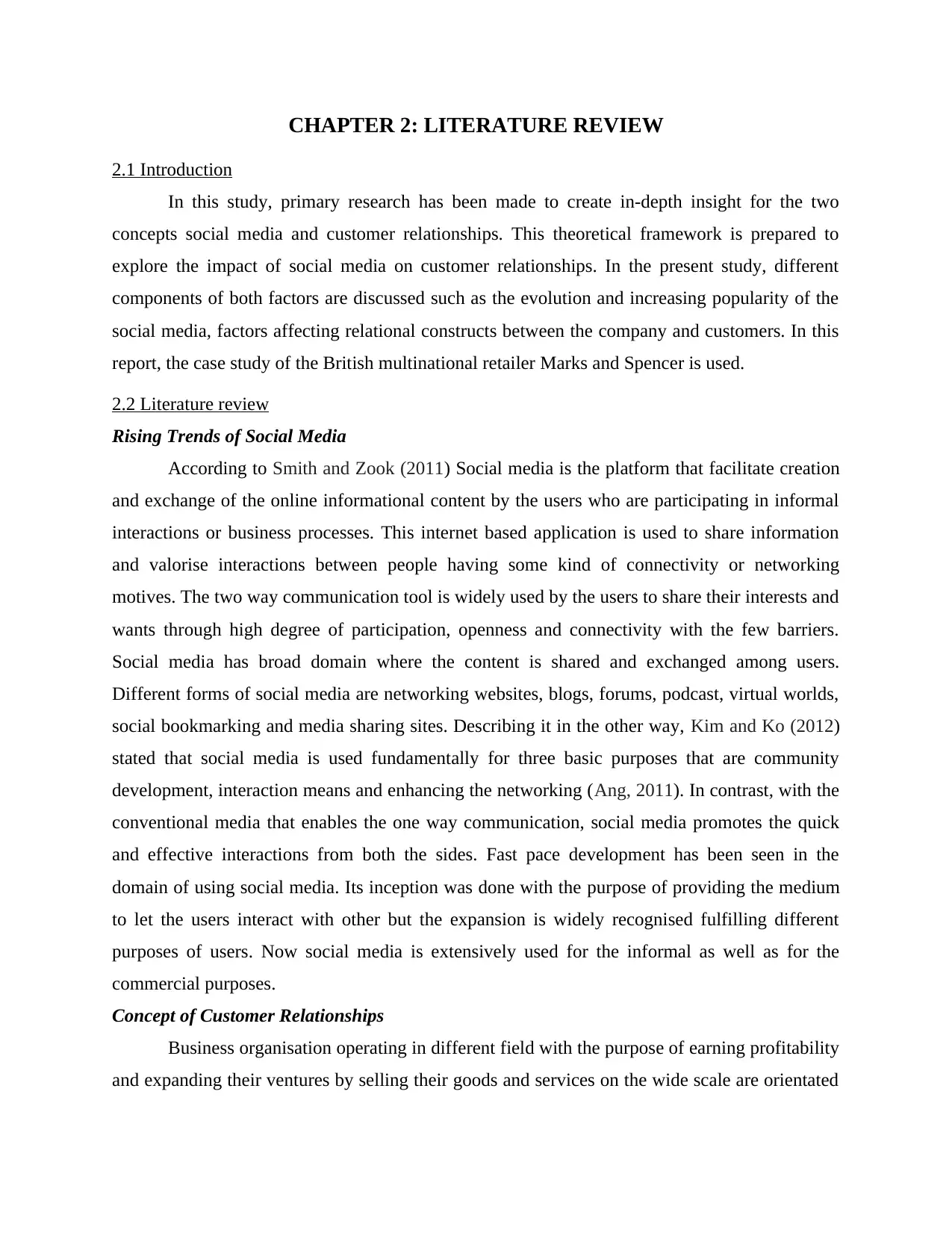
CHAPTER 2: LITERATURE REVIEW
2.1 Introduction
In this study, primary research has been made to create in-depth insight for the two
concepts social media and customer relationships. This theoretical framework is prepared to
explore the impact of social media on customer relationships. In the present study, different
components of both factors are discussed such as the evolution and increasing popularity of the
social media, factors affecting relational constructs between the company and customers. In this
report, the case study of the British multinational retailer Marks and Spencer is used.
2.2 Literature review
Rising Trends of Social Media
According to Smith and Zook (2011) Social media is the platform that facilitate creation
and exchange of the online informational content by the users who are participating in informal
interactions or business processes. This internet based application is used to share information
and valorise interactions between people having some kind of connectivity or networking
motives. The two way communication tool is widely used by the users to share their interests and
wants through high degree of participation, openness and connectivity with the few barriers.
Social media has broad domain where the content is shared and exchanged among users.
Different forms of social media are networking websites, blogs, forums, podcast, virtual worlds,
social bookmarking and media sharing sites. Describing it in the other way, Kim and Ko (2012)
stated that social media is used fundamentally for three basic purposes that are community
development, interaction means and enhancing the networking (Ang, 2011). In contrast, with the
conventional media that enables the one way communication, social media promotes the quick
and effective interactions from both the sides. Fast pace development has been seen in the
domain of using social media. Its inception was done with the purpose of providing the medium
to let the users interact with other but the expansion is widely recognised fulfilling different
purposes of users. Now social media is extensively used for the informal as well as for the
commercial purposes.
Concept of Customer Relationships
Business organisation operating in different field with the purpose of earning profitability
and expanding their ventures by selling their goods and services on the wide scale are orientated
2.1 Introduction
In this study, primary research has been made to create in-depth insight for the two
concepts social media and customer relationships. This theoretical framework is prepared to
explore the impact of social media on customer relationships. In the present study, different
components of both factors are discussed such as the evolution and increasing popularity of the
social media, factors affecting relational constructs between the company and customers. In this
report, the case study of the British multinational retailer Marks and Spencer is used.
2.2 Literature review
Rising Trends of Social Media
According to Smith and Zook (2011) Social media is the platform that facilitate creation
and exchange of the online informational content by the users who are participating in informal
interactions or business processes. This internet based application is used to share information
and valorise interactions between people having some kind of connectivity or networking
motives. The two way communication tool is widely used by the users to share their interests and
wants through high degree of participation, openness and connectivity with the few barriers.
Social media has broad domain where the content is shared and exchanged among users.
Different forms of social media are networking websites, blogs, forums, podcast, virtual worlds,
social bookmarking and media sharing sites. Describing it in the other way, Kim and Ko (2012)
stated that social media is used fundamentally for three basic purposes that are community
development, interaction means and enhancing the networking (Ang, 2011). In contrast, with the
conventional media that enables the one way communication, social media promotes the quick
and effective interactions from both the sides. Fast pace development has been seen in the
domain of using social media. Its inception was done with the purpose of providing the medium
to let the users interact with other but the expansion is widely recognised fulfilling different
purposes of users. Now social media is extensively used for the informal as well as for the
commercial purposes.
Concept of Customer Relationships
Business organisation operating in different field with the purpose of earning profitability
and expanding their ventures by selling their goods and services on the wide scale are orientated
Paraphrase This Document
Need a fresh take? Get an instant paraphrase of this document with our AI Paraphraser
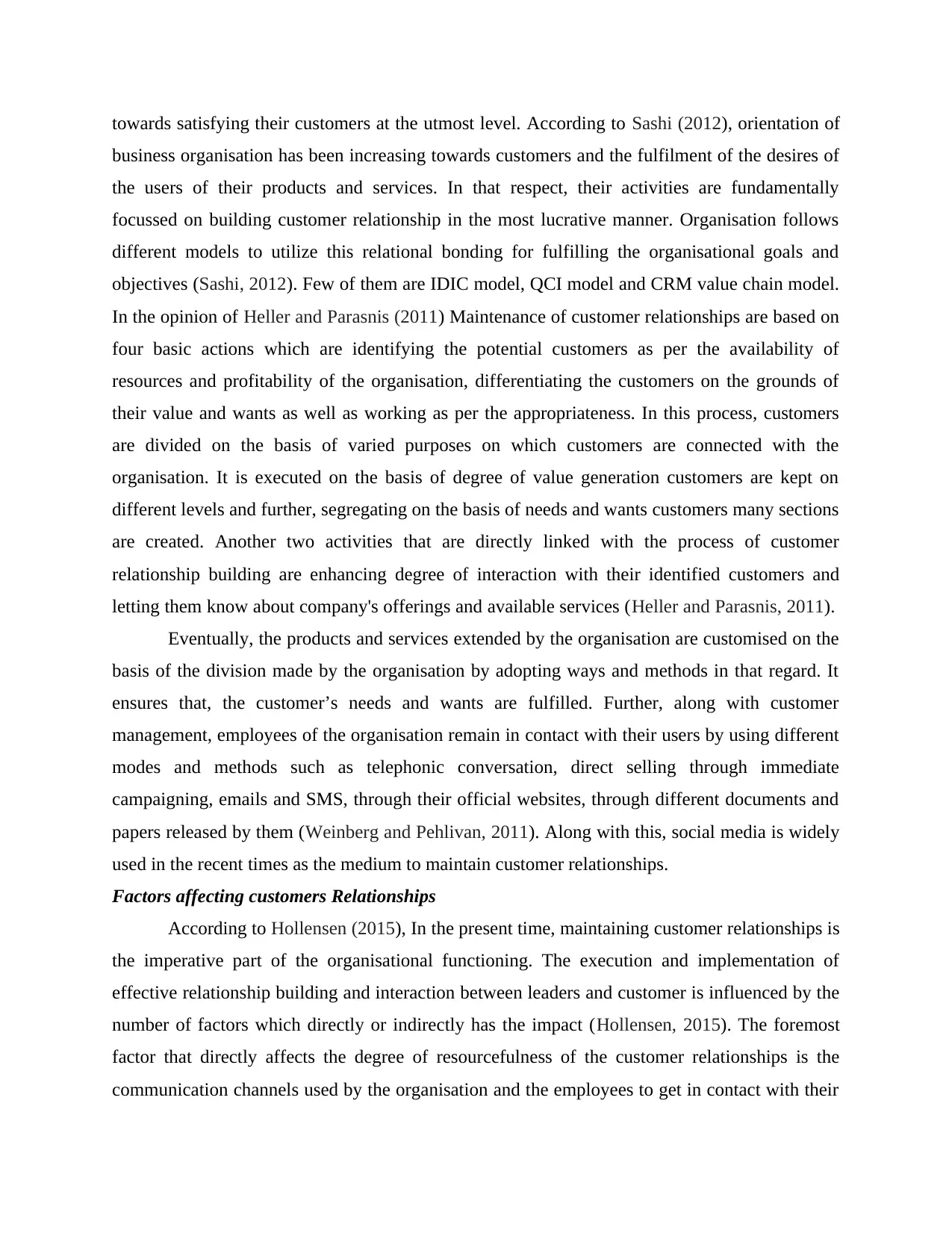
towards satisfying their customers at the utmost level. According to Sashi (2012), orientation of
business organisation has been increasing towards customers and the fulfilment of the desires of
the users of their products and services. In that respect, their activities are fundamentally
focussed on building customer relationship in the most lucrative manner. Organisation follows
different models to utilize this relational bonding for fulfilling the organisational goals and
objectives (Sashi, 2012). Few of them are IDIC model, QCI model and CRM value chain model.
In the opinion of Heller and Parasnis (2011) Maintenance of customer relationships are based on
four basic actions which are identifying the potential customers as per the availability of
resources and profitability of the organisation, differentiating the customers on the grounds of
their value and wants as well as working as per the appropriateness. In this process, customers
are divided on the basis of varied purposes on which customers are connected with the
organisation. It is executed on the basis of degree of value generation customers are kept on
different levels and further, segregating on the basis of needs and wants customers many sections
are created. Another two activities that are directly linked with the process of customer
relationship building are enhancing degree of interaction with their identified customers and
letting them know about company's offerings and available services (Heller and Parasnis, 2011).
Eventually, the products and services extended by the organisation are customised on the
basis of the division made by the organisation by adopting ways and methods in that regard. It
ensures that, the customer’s needs and wants are fulfilled. Further, along with customer
management, employees of the organisation remain in contact with their users by using different
modes and methods such as telephonic conversation, direct selling through immediate
campaigning, emails and SMS, through their official websites, through different documents and
papers released by them (Weinberg and Pehlivan, 2011). Along with this, social media is widely
used in the recent times as the medium to maintain customer relationships.
Factors affecting customers Relationships
According to Hollensen (2015), In the present time, maintaining customer relationships is
the imperative part of the organisational functioning. The execution and implementation of
effective relationship building and interaction between leaders and customer is influenced by the
number of factors which directly or indirectly has the impact (Hollensen, 2015). The foremost
factor that directly affects the degree of resourcefulness of the customer relationships is the
communication channels used by the organisation and the employees to get in contact with their
business organisation has been increasing towards customers and the fulfilment of the desires of
the users of their products and services. In that respect, their activities are fundamentally
focussed on building customer relationship in the most lucrative manner. Organisation follows
different models to utilize this relational bonding for fulfilling the organisational goals and
objectives (Sashi, 2012). Few of them are IDIC model, QCI model and CRM value chain model.
In the opinion of Heller and Parasnis (2011) Maintenance of customer relationships are based on
four basic actions which are identifying the potential customers as per the availability of
resources and profitability of the organisation, differentiating the customers on the grounds of
their value and wants as well as working as per the appropriateness. In this process, customers
are divided on the basis of varied purposes on which customers are connected with the
organisation. It is executed on the basis of degree of value generation customers are kept on
different levels and further, segregating on the basis of needs and wants customers many sections
are created. Another two activities that are directly linked with the process of customer
relationship building are enhancing degree of interaction with their identified customers and
letting them know about company's offerings and available services (Heller and Parasnis, 2011).
Eventually, the products and services extended by the organisation are customised on the
basis of the division made by the organisation by adopting ways and methods in that regard. It
ensures that, the customer’s needs and wants are fulfilled. Further, along with customer
management, employees of the organisation remain in contact with their users by using different
modes and methods such as telephonic conversation, direct selling through immediate
campaigning, emails and SMS, through their official websites, through different documents and
papers released by them (Weinberg and Pehlivan, 2011). Along with this, social media is widely
used in the recent times as the medium to maintain customer relationships.
Factors affecting customers Relationships
According to Hollensen (2015), In the present time, maintaining customer relationships is
the imperative part of the organisational functioning. The execution and implementation of
effective relationship building and interaction between leaders and customer is influenced by the
number of factors which directly or indirectly has the impact (Hollensen, 2015). The foremost
factor that directly affects the degree of resourcefulness of the customer relationships is the
communication channels used by the organisation and the employees to get in contact with their
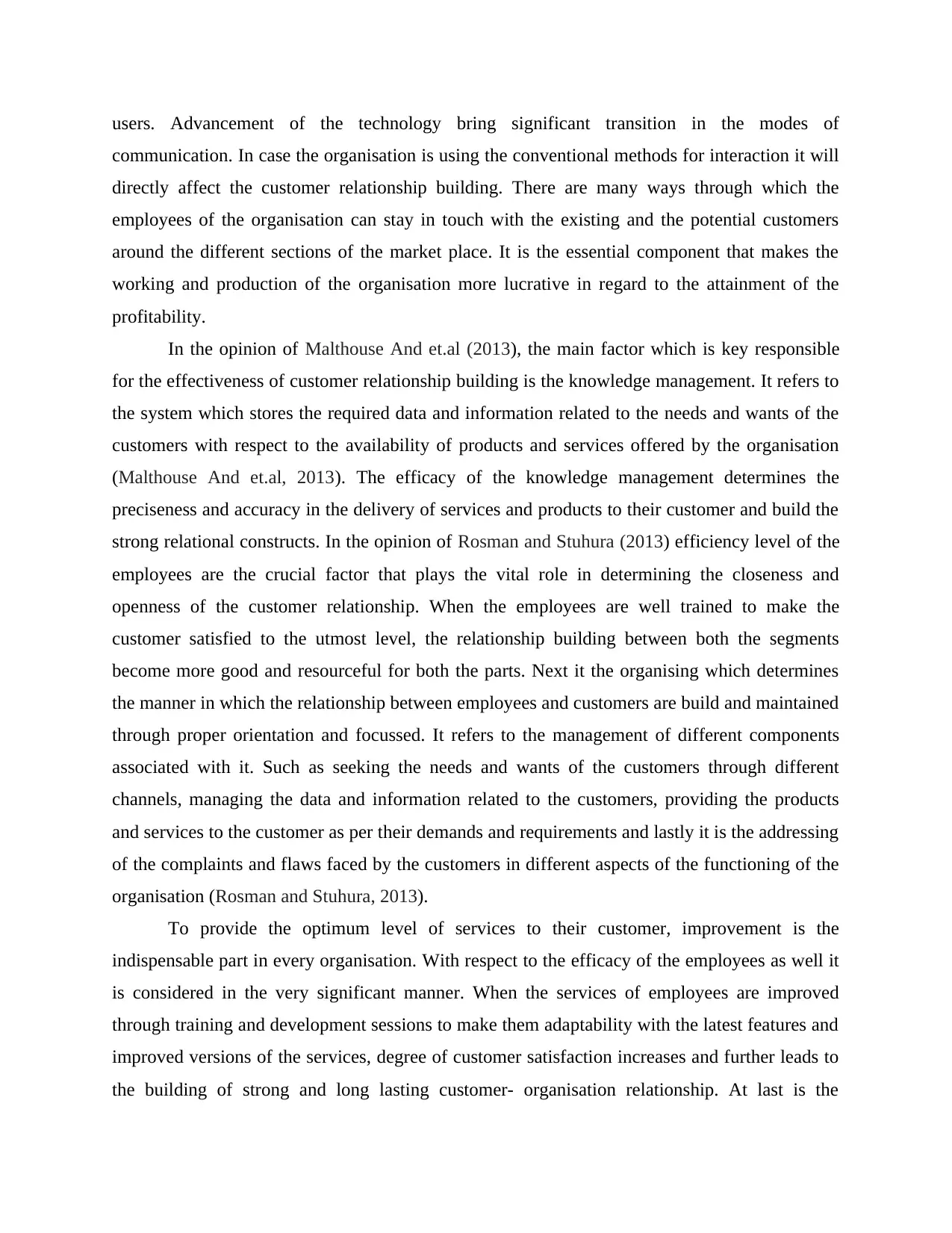
users. Advancement of the technology bring significant transition in the modes of
communication. In case the organisation is using the conventional methods for interaction it will
directly affect the customer relationship building. There are many ways through which the
employees of the organisation can stay in touch with the existing and the potential customers
around the different sections of the market place. It is the essential component that makes the
working and production of the organisation more lucrative in regard to the attainment of the
profitability.
In the opinion of Malthouse And et.al (2013), the main factor which is key responsible
for the effectiveness of customer relationship building is the knowledge management. It refers to
the system which stores the required data and information related to the needs and wants of the
customers with respect to the availability of products and services offered by the organisation
(Malthouse And et.al, 2013). The efficacy of the knowledge management determines the
preciseness and accuracy in the delivery of services and products to their customer and build the
strong relational constructs. In the opinion of Rosman and Stuhura (2013) efficiency level of the
employees are the crucial factor that plays the vital role in determining the closeness and
openness of the customer relationship. When the employees are well trained to make the
customer satisfied to the utmost level, the relationship building between both the segments
become more good and resourceful for both the parts. Next it the organising which determines
the manner in which the relationship between employees and customers are build and maintained
through proper orientation and focussed. It refers to the management of different components
associated with it. Such as seeking the needs and wants of the customers through different
channels, managing the data and information related to the customers, providing the products
and services to the customer as per their demands and requirements and lastly it is the addressing
of the complaints and flaws faced by the customers in different aspects of the functioning of the
organisation (Rosman and Stuhura, 2013).
To provide the optimum level of services to their customer, improvement is the
indispensable part in every organisation. With respect to the efficacy of the employees as well it
is considered in the very significant manner. When the services of employees are improved
through training and development sessions to make them adaptability with the latest features and
improved versions of the services, degree of customer satisfaction increases and further leads to
the building of strong and long lasting customer- organisation relationship. At last is the
communication. In case the organisation is using the conventional methods for interaction it will
directly affect the customer relationship building. There are many ways through which the
employees of the organisation can stay in touch with the existing and the potential customers
around the different sections of the market place. It is the essential component that makes the
working and production of the organisation more lucrative in regard to the attainment of the
profitability.
In the opinion of Malthouse And et.al (2013), the main factor which is key responsible
for the effectiveness of customer relationship building is the knowledge management. It refers to
the system which stores the required data and information related to the needs and wants of the
customers with respect to the availability of products and services offered by the organisation
(Malthouse And et.al, 2013). The efficacy of the knowledge management determines the
preciseness and accuracy in the delivery of services and products to their customer and build the
strong relational constructs. In the opinion of Rosman and Stuhura (2013) efficiency level of the
employees are the crucial factor that plays the vital role in determining the closeness and
openness of the customer relationship. When the employees are well trained to make the
customer satisfied to the utmost level, the relationship building between both the segments
become more good and resourceful for both the parts. Next it the organising which determines
the manner in which the relationship between employees and customers are build and maintained
through proper orientation and focussed. It refers to the management of different components
associated with it. Such as seeking the needs and wants of the customers through different
channels, managing the data and information related to the customers, providing the products
and services to the customer as per their demands and requirements and lastly it is the addressing
of the complaints and flaws faced by the customers in different aspects of the functioning of the
organisation (Rosman and Stuhura, 2013).
To provide the optimum level of services to their customer, improvement is the
indispensable part in every organisation. With respect to the efficacy of the employees as well it
is considered in the very significant manner. When the services of employees are improved
through training and development sessions to make them adaptability with the latest features and
improved versions of the services, degree of customer satisfaction increases and further leads to
the building of strong and long lasting customer- organisation relationship. At last is the
⊘ This is a preview!⊘
Do you want full access?
Subscribe today to unlock all pages.

Trusted by 1+ million students worldwide
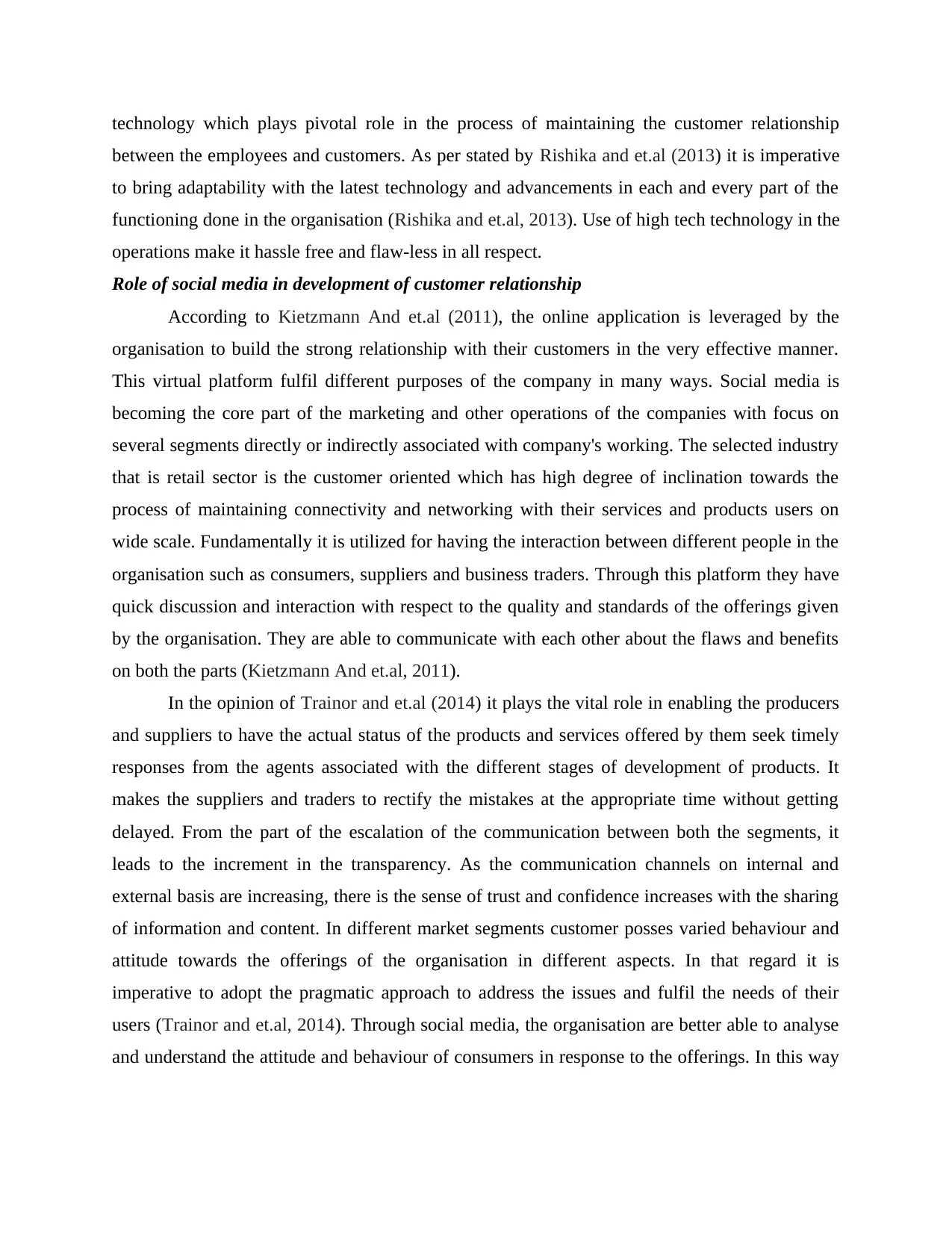
technology which plays pivotal role in the process of maintaining the customer relationship
between the employees and customers. As per stated by Rishika and et.al (2013) it is imperative
to bring adaptability with the latest technology and advancements in each and every part of the
functioning done in the organisation (Rishika and et.al, 2013). Use of high tech technology in the
operations make it hassle free and flaw-less in all respect.
Role of social media in development of customer relationship
According to Kietzmann And et.al (2011), the online application is leveraged by the
organisation to build the strong relationship with their customers in the very effective manner.
This virtual platform fulfil different purposes of the company in many ways. Social media is
becoming the core part of the marketing and other operations of the companies with focus on
several segments directly or indirectly associated with company's working. The selected industry
that is retail sector is the customer oriented which has high degree of inclination towards the
process of maintaining connectivity and networking with their services and products users on
wide scale. Fundamentally it is utilized for having the interaction between different people in the
organisation such as consumers, suppliers and business traders. Through this platform they have
quick discussion and interaction with respect to the quality and standards of the offerings given
by the organisation. They are able to communicate with each other about the flaws and benefits
on both the parts (Kietzmann And et.al, 2011).
In the opinion of Trainor and et.al (2014) it plays the vital role in enabling the producers
and suppliers to have the actual status of the products and services offered by them seek timely
responses from the agents associated with the different stages of development of products. It
makes the suppliers and traders to rectify the mistakes at the appropriate time without getting
delayed. From the part of the escalation of the communication between both the segments, it
leads to the increment in the transparency. As the communication channels on internal and
external basis are increasing, there is the sense of trust and confidence increases with the sharing
of information and content. In different market segments customer posses varied behaviour and
attitude towards the offerings of the organisation in different aspects. In that regard it is
imperative to adopt the pragmatic approach to address the issues and fulfil the needs of their
users (Trainor and et.al, 2014). Through social media, the organisation are better able to analyse
and understand the attitude and behaviour of consumers in response to the offerings. In this way
between the employees and customers. As per stated by Rishika and et.al (2013) it is imperative
to bring adaptability with the latest technology and advancements in each and every part of the
functioning done in the organisation (Rishika and et.al, 2013). Use of high tech technology in the
operations make it hassle free and flaw-less in all respect.
Role of social media in development of customer relationship
According to Kietzmann And et.al (2011), the online application is leveraged by the
organisation to build the strong relationship with their customers in the very effective manner.
This virtual platform fulfil different purposes of the company in many ways. Social media is
becoming the core part of the marketing and other operations of the companies with focus on
several segments directly or indirectly associated with company's working. The selected industry
that is retail sector is the customer oriented which has high degree of inclination towards the
process of maintaining connectivity and networking with their services and products users on
wide scale. Fundamentally it is utilized for having the interaction between different people in the
organisation such as consumers, suppliers and business traders. Through this platform they have
quick discussion and interaction with respect to the quality and standards of the offerings given
by the organisation. They are able to communicate with each other about the flaws and benefits
on both the parts (Kietzmann And et.al, 2011).
In the opinion of Trainor and et.al (2014) it plays the vital role in enabling the producers
and suppliers to have the actual status of the products and services offered by them seek timely
responses from the agents associated with the different stages of development of products. It
makes the suppliers and traders to rectify the mistakes at the appropriate time without getting
delayed. From the part of the escalation of the communication between both the segments, it
leads to the increment in the transparency. As the communication channels on internal and
external basis are increasing, there is the sense of trust and confidence increases with the sharing
of information and content. In different market segments customer posses varied behaviour and
attitude towards the offerings of the organisation in different aspects. In that regard it is
imperative to adopt the pragmatic approach to address the issues and fulfil the needs of their
users (Trainor and et.al, 2014). Through social media, the organisation are better able to analyse
and understand the attitude and behaviour of consumers in response to the offerings. In this way
Paraphrase This Document
Need a fresh take? Get an instant paraphrase of this document with our AI Paraphraser
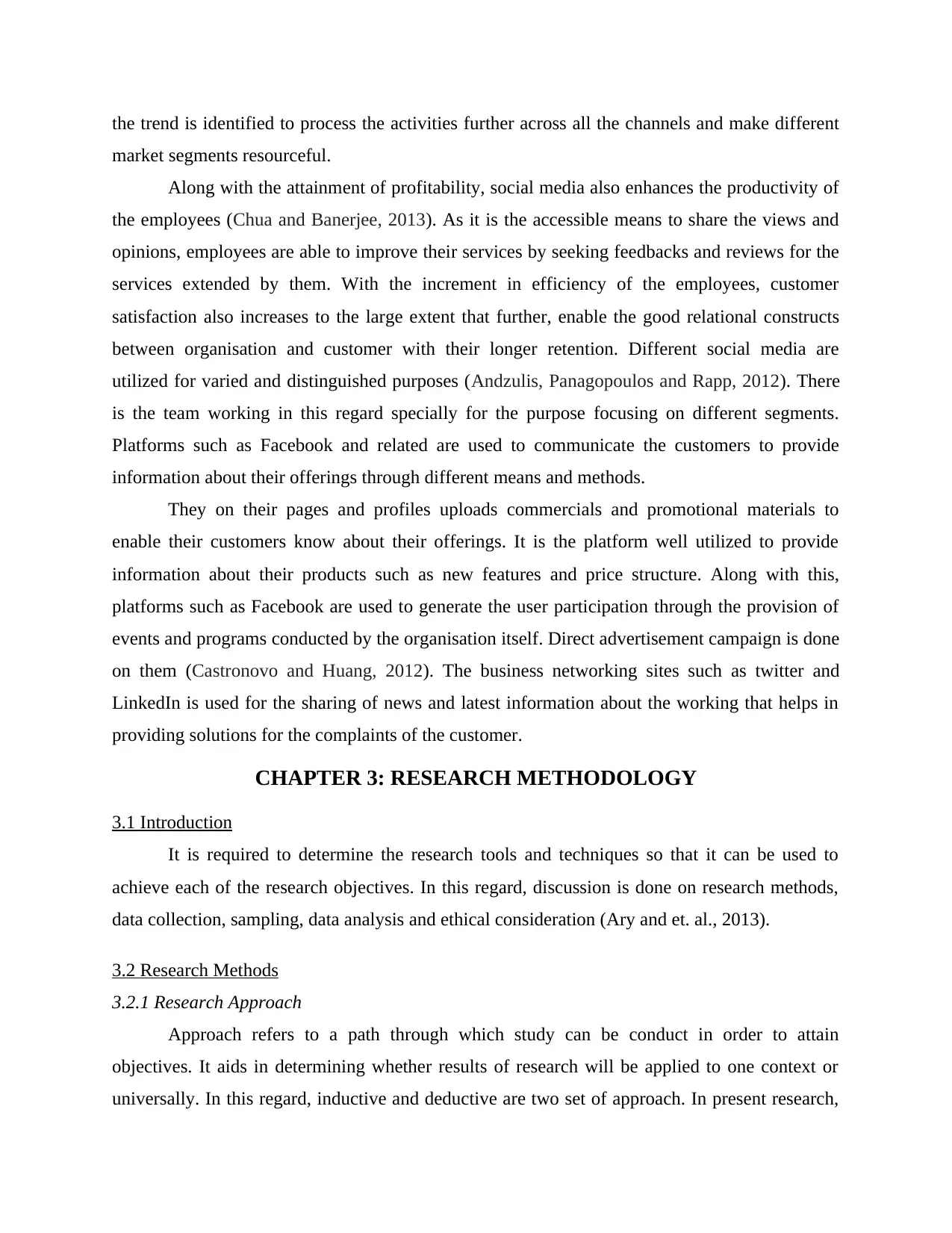
the trend is identified to process the activities further across all the channels and make different
market segments resourceful.
Along with the attainment of profitability, social media also enhances the productivity of
the employees (Chua and Banerjee, 2013). As it is the accessible means to share the views and
opinions, employees are able to improve their services by seeking feedbacks and reviews for the
services extended by them. With the increment in efficiency of the employees, customer
satisfaction also increases to the large extent that further, enable the good relational constructs
between organisation and customer with their longer retention. Different social media are
utilized for varied and distinguished purposes (Andzulis, Panagopoulos and Rapp, 2012). There
is the team working in this regard specially for the purpose focusing on different segments.
Platforms such as Facebook and related are used to communicate the customers to provide
information about their offerings through different means and methods.
They on their pages and profiles uploads commercials and promotional materials to
enable their customers know about their offerings. It is the platform well utilized to provide
information about their products such as new features and price structure. Along with this,
platforms such as Facebook are used to generate the user participation through the provision of
events and programs conducted by the organisation itself. Direct advertisement campaign is done
on them (Castronovo and Huang, 2012). The business networking sites such as twitter and
LinkedIn is used for the sharing of news and latest information about the working that helps in
providing solutions for the complaints of the customer.
CHAPTER 3: RESEARCH METHODOLOGY
3.1 Introduction
It is required to determine the research tools and techniques so that it can be used to
achieve each of the research objectives. In this regard, discussion is done on research methods,
data collection, sampling, data analysis and ethical consideration (Ary and et. al., 2013).
3.2 Research Methods
3.2.1 Research Approach
Approach refers to a path through which study can be conduct in order to attain
objectives. It aids in determining whether results of research will be applied to one context or
universally. In this regard, inductive and deductive are two set of approach. In present research,
market segments resourceful.
Along with the attainment of profitability, social media also enhances the productivity of
the employees (Chua and Banerjee, 2013). As it is the accessible means to share the views and
opinions, employees are able to improve their services by seeking feedbacks and reviews for the
services extended by them. With the increment in efficiency of the employees, customer
satisfaction also increases to the large extent that further, enable the good relational constructs
between organisation and customer with their longer retention. Different social media are
utilized for varied and distinguished purposes (Andzulis, Panagopoulos and Rapp, 2012). There
is the team working in this regard specially for the purpose focusing on different segments.
Platforms such as Facebook and related are used to communicate the customers to provide
information about their offerings through different means and methods.
They on their pages and profiles uploads commercials and promotional materials to
enable their customers know about their offerings. It is the platform well utilized to provide
information about their products such as new features and price structure. Along with this,
platforms such as Facebook are used to generate the user participation through the provision of
events and programs conducted by the organisation itself. Direct advertisement campaign is done
on them (Castronovo and Huang, 2012). The business networking sites such as twitter and
LinkedIn is used for the sharing of news and latest information about the working that helps in
providing solutions for the complaints of the customer.
CHAPTER 3: RESEARCH METHODOLOGY
3.1 Introduction
It is required to determine the research tools and techniques so that it can be used to
achieve each of the research objectives. In this regard, discussion is done on research methods,
data collection, sampling, data analysis and ethical consideration (Ary and et. al., 2013).
3.2 Research Methods
3.2.1 Research Approach
Approach refers to a path through which study can be conduct in order to attain
objectives. It aids in determining whether results of research will be applied to one context or
universally. In this regard, inductive and deductive are two set of approach. In present research,
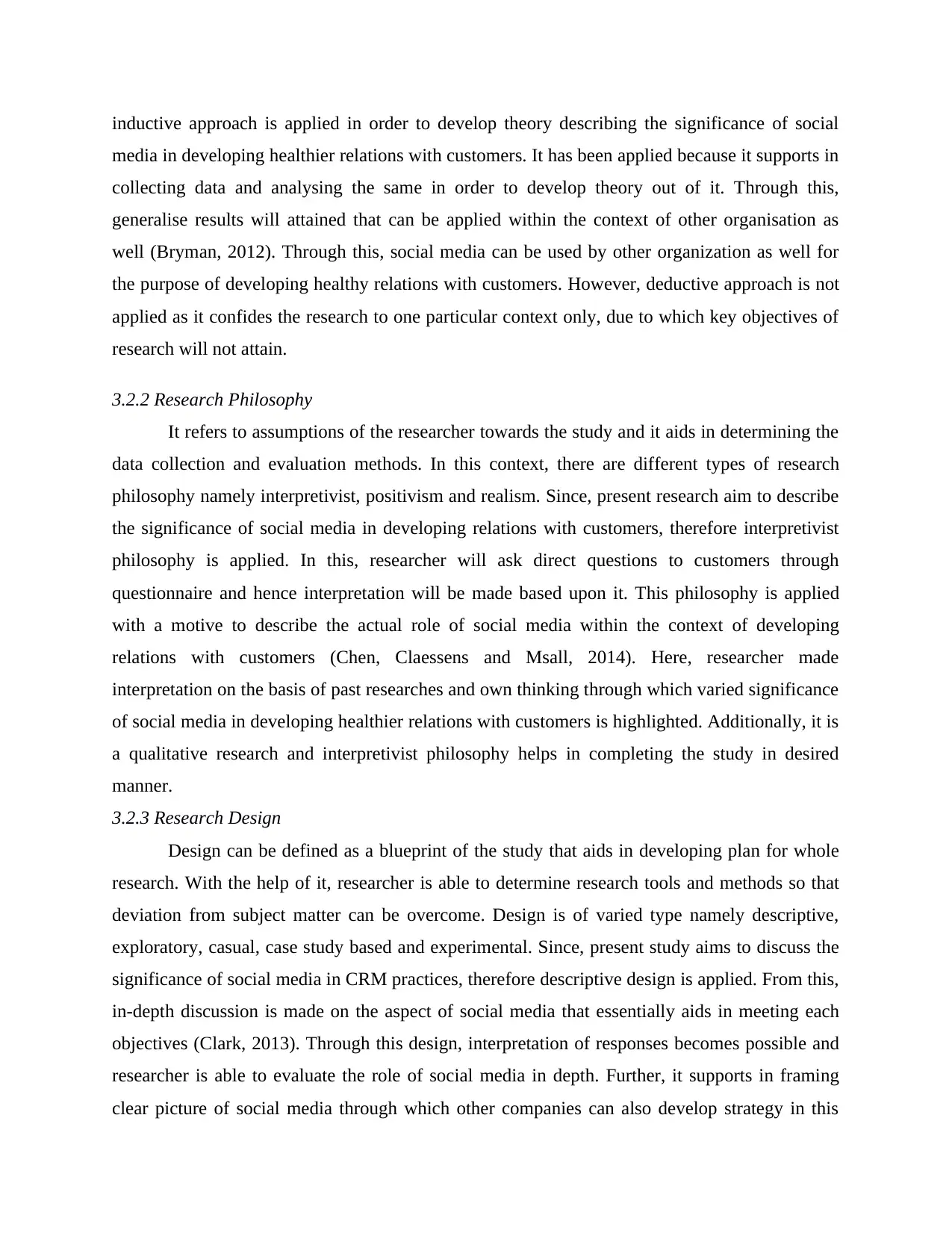
inductive approach is applied in order to develop theory describing the significance of social
media in developing healthier relations with customers. It has been applied because it supports in
collecting data and analysing the same in order to develop theory out of it. Through this,
generalise results will attained that can be applied within the context of other organisation as
well (Bryman, 2012). Through this, social media can be used by other organization as well for
the purpose of developing healthy relations with customers. However, deductive approach is not
applied as it confides the research to one particular context only, due to which key objectives of
research will not attain.
3.2.2 Research Philosophy
It refers to assumptions of the researcher towards the study and it aids in determining the
data collection and evaluation methods. In this context, there are different types of research
philosophy namely interpretivist, positivism and realism. Since, present research aim to describe
the significance of social media in developing relations with customers, therefore interpretivist
philosophy is applied. In this, researcher will ask direct questions to customers through
questionnaire and hence interpretation will be made based upon it. This philosophy is applied
with a motive to describe the actual role of social media within the context of developing
relations with customers (Chen, Claessens and Msall, 2014). Here, researcher made
interpretation on the basis of past researches and own thinking through which varied significance
of social media in developing healthier relations with customers is highlighted. Additionally, it is
a qualitative research and interpretivist philosophy helps in completing the study in desired
manner.
3.2.3 Research Design
Design can be defined as a blueprint of the study that aids in developing plan for whole
research. With the help of it, researcher is able to determine research tools and methods so that
deviation from subject matter can be overcome. Design is of varied type namely descriptive,
exploratory, casual, case study based and experimental. Since, present study aims to discuss the
significance of social media in CRM practices, therefore descriptive design is applied. From this,
in-depth discussion is made on the aspect of social media that essentially aids in meeting each
objectives (Clark, 2013). Through this design, interpretation of responses becomes possible and
researcher is able to evaluate the role of social media in depth. Further, it supports in framing
clear picture of social media through which other companies can also develop strategy in this
media in developing healthier relations with customers. It has been applied because it supports in
collecting data and analysing the same in order to develop theory out of it. Through this,
generalise results will attained that can be applied within the context of other organisation as
well (Bryman, 2012). Through this, social media can be used by other organization as well for
the purpose of developing healthy relations with customers. However, deductive approach is not
applied as it confides the research to one particular context only, due to which key objectives of
research will not attain.
3.2.2 Research Philosophy
It refers to assumptions of the researcher towards the study and it aids in determining the
data collection and evaluation methods. In this context, there are different types of research
philosophy namely interpretivist, positivism and realism. Since, present research aim to describe
the significance of social media in developing relations with customers, therefore interpretivist
philosophy is applied. In this, researcher will ask direct questions to customers through
questionnaire and hence interpretation will be made based upon it. This philosophy is applied
with a motive to describe the actual role of social media within the context of developing
relations with customers (Chen, Claessens and Msall, 2014). Here, researcher made
interpretation on the basis of past researches and own thinking through which varied significance
of social media in developing healthier relations with customers is highlighted. Additionally, it is
a qualitative research and interpretivist philosophy helps in completing the study in desired
manner.
3.2.3 Research Design
Design can be defined as a blueprint of the study that aids in developing plan for whole
research. With the help of it, researcher is able to determine research tools and methods so that
deviation from subject matter can be overcome. Design is of varied type namely descriptive,
exploratory, casual, case study based and experimental. Since, present study aims to discuss the
significance of social media in CRM practices, therefore descriptive design is applied. From this,
in-depth discussion is made on the aspect of social media that essentially aids in meeting each
objectives (Clark, 2013). Through this design, interpretation of responses becomes possible and
researcher is able to evaluate the role of social media in depth. Further, it supports in framing
clear picture of social media through which other companies can also develop strategy in this
⊘ This is a preview!⊘
Do you want full access?
Subscribe today to unlock all pages.

Trusted by 1+ million students worldwide
1 out of 29
Related Documents
Your All-in-One AI-Powered Toolkit for Academic Success.
+13062052269
info@desklib.com
Available 24*7 on WhatsApp / Email
![[object Object]](/_next/static/media/star-bottom.7253800d.svg)
Unlock your academic potential
Copyright © 2020–2025 A2Z Services. All Rights Reserved. Developed and managed by ZUCOL.





